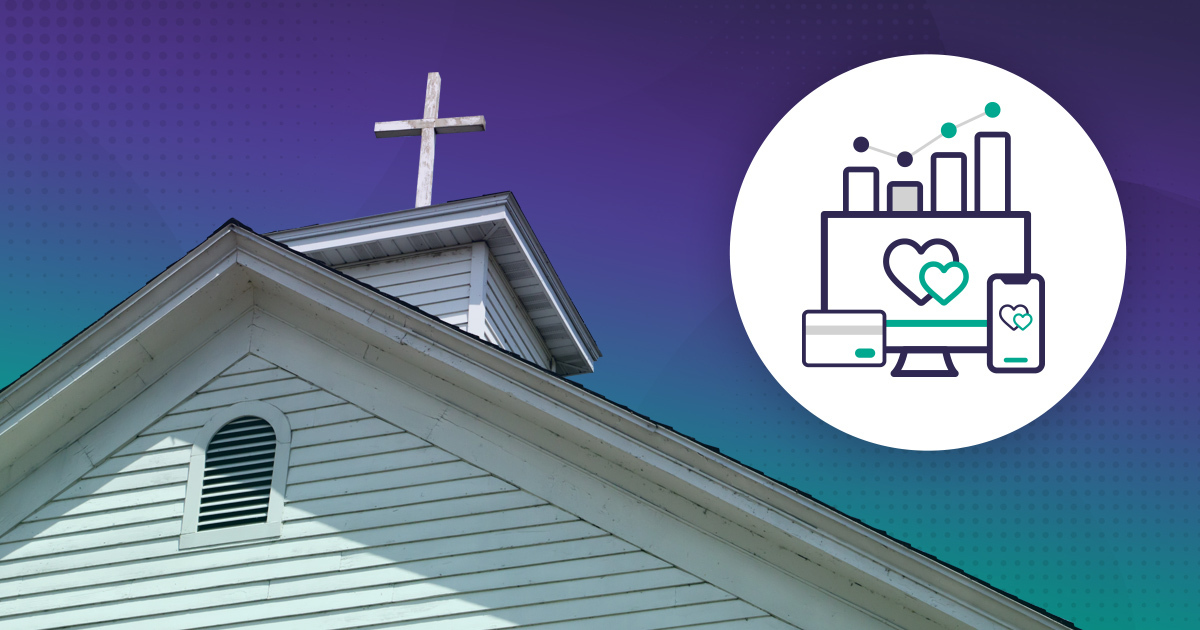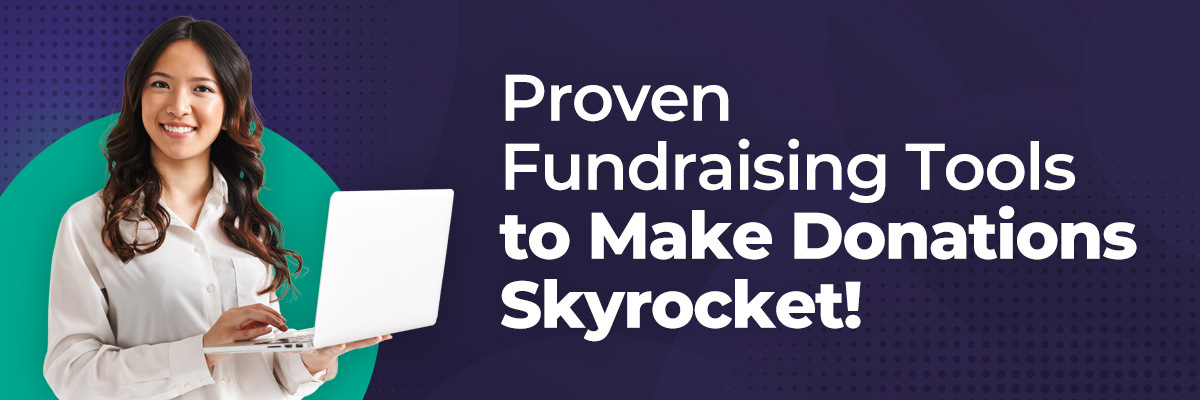
Fundraising is tough. It can be even more challenging if you don’t have modern tools at your disposal. Donation tools provide analytics on your campaign's success, keep track of donors, and save money in the fundraising process. Without them, your campaigns would be disorganized, and you would be dealing with limited engagement and lower ROIs.
This article will discuss the donation tools you need to support fundraising success and why they are so valuable.
Table of Contents
- Benefits of Utilizing the Right Donation Tools
- Essential Features of Effective Donation Tools
- What Donation Tools Should I Include in My Fundraising Campaign?
- Tips for Choosing the Right Donation Tools for Your Nonprofit
- FAQs
- 100+ Free Tools & Templates to Help with Your Nonprofit
Benefits of Utilizing the Right Donation Tools

Here are some benefits modern donation tools provide.
- Increased Engagement: Fundraising is contingent on engagement. Engagement ensures donors don’t forget about your cause. They make donors aware of your latest challenges and accomplishments and promote a sense of caring. Modern donation tools can be used to send out online communication through emails and social media to ensure ongoing engagement.
- Payment Collection: Once upon a time, nonprofits could only collect payments through face-to-face interactions. Today, there are online platforms that collect donations and even encourage recurring donations. New systems reduce the time and effort involved in the fundraising process.
- Enhanced Insights: Fundraising organizations rely on analytics to determine which systems are effective. Donation tools tell them how well their campaigns performed in terms of new donors, donation amounts, and donation frequency. Without them, your organization cannot identify areas of improvement.
- Cost-Effective: You spend money to make money, but nonprofits must make sure their efforts pay off. Modern tools utilize virtual systems which tend to reduce expenses leading to higher ROIs.
- Better Management: Donor tracking for nonprofits is essential. Organizations must go beyond storing contact information. They must use systems that indicate where donors are in the donation funnel so they can customize communication accordingly. Customer relationship management systems can help them achieve that goal.
Essential Features of Effective Donation Tools

Nonprofits must choose donation tools with key features in mind. Here are some characteristics to look out for.
- Security: Charity organizations often store sensitive donor data including billing and contact information. Systems must be secure to ensure this information is protected. Look for features like encryption, firewalls, antivirus software, intrusion/prevention systems, access controls, and automatic updates.
- Ease of Use: Choose systems that your team can adapt to easily. Your nonprofit tools should feature an intuitive design and require a minimal learning curve. It should offer a consistent layout, clear visual cues, error prevention, and drag-and-drop functionality. Avoid tools that require extensive team training.
- Customization: Your donation tools should be customizable ensuring they meet your organizational needs. Basic users should be able to adjust settings, choose menu options, or alter the user interface to personalize their experience. However, some systems may require coding knowledge and advanced technical skills to customize. You may want to avoid these products unless you have a skilled IT team to help.
- Mobile-Friendly Options: Team members often want the option to control their tools from remote locations. Ensure your tools are mobile-friendly so you can adjust them from anywhere at any time. Some tools will also adjust to mobile screens for optimal reach when communicating with donors.
- Integration with Other Software: Ensure donation tools integrate with your existing software. This ensures a seamless transition of data and supports productivity. It can also lead to enhanced data accuracy and better insights which support effective decision making. An integrated system improves security and provides better customer experiences.
What Donation Tools Should I Include in My Fundraising Campaign?
Recommended fundraising tools include:
Tool #1: Online Donation Platforms
An online donation platform allows nonprofits to securely collect and process donations. Donors will typically access the donor form on the platform website. The platform will do the rest, securely connecting to various payment vendors to ensure convenience and ease of use.
Most online donation platforms allow donors to check off a box for recurring donations ensuring regular income. Some may have more advanced features such as crowdfunding, event ticketing, memberships, text to give, peer-to-peer campaigns, and donor management systems. Nonprofits can use these features to advertise their pages to increase donation potential.
Here are some platforms that are recommended for donor convenience:
- Vanco: Vanco offers a simple system for payment processing and financial management. The system creates church donation pages that narrate a compelling story that boosts donor engagement. We offer a simplified donation journey that expands reach, boosts cash flow, and makes church budgets more stable.
- Donorbox: Donorbox allows you to create customized donation forms and start fundraising instantly. Nonprofits can set up various campaigns such as peer-to-peer, text-to-give, and membership campaigns. It also provides event management for live and web-based events. The system offers customized features for donors allowing them to choose their cause and manage accounts. It also manages donor relationships, accepts donations via various payment apps, and connects with existing systems.
- Fundly: Fundly allows small profits to try out crowdfunding without paying for expensive software. They can connect with donors through social media to raise funds for special programs. The platform is easy to use and provides fundraising feedback from remote locations. It integrates with various systems and supports event management and peer-to-peer fundraising for nonprofits. The system also offers data analytics on fundraising efforts.
- OneCause: OneCause allows nonprofits to set up online campaigns, launch challenges, and grow their reach. It supports event management, peer-to-peer fundraising, mobile bidding, auctions and text-to-give.
- Tithely: Tithely is a ministry-focused provider that offers a church management system. The platform is easy to use and can connect to a mobile app for optimal management convenience. It connects to various bank accounts, so funds get to where they need to be.
Tool #2: Mobile Donation Solutions
Mobile donations are an excellent solution for today’s fast-paced society. Donation requests are sent directly to donors' phones increasing open rates and engagement. Recipients can click a link to navigate directly to the donor page from wherever they are.
Text to give is a convenient donation system because it reaches donors where they are. According to MatchPro, SMS open rates are as high as 98%. 22% of nonprofits use text to give and the average gift is $79.
Examples of successful text to give campaigns include:
- Tres Hermano’s Foundation Freedom Book Drive: The foundation raised $43,670 to support their efforts to distribute books to incarcerated men, women and children.
- Cooke Revival Ministries raised $33,944 to support their church.
- The Gathering Church used text to give to raise $19,387 in tithes and offerings.
Ensure your text-to-give campaign is successful by offering a donation form that is simple to fill out for people on the go. It should be formatted properly for mobile devices. Use big buttons and fields that are easy to tap on small cellphone screens.
This video will provide more information to help you launch your text-to-give campaign.
Tool #3: Recurring Donation Setup
A recurring donation setup allows nonprofits to collect passive income. It can be set up through online donation and text-to-give platforms. When donors donate, they have the option to sign up for a recurring donation meaning the system will automatically withdraw the specified amount on a set schedule.
A recurring donation system can bring in considerable returns. According to a Candid report, recurring donors donate 440% more to charity than one-time donors and 42% more than people who create personal fundraising pages to support a cause. In fact, in a study of 25,000 organizations, Vanco found similar results. With increases in giving by 200%, recurring giving remains a potent tool for nonprofits.
Recurring donations also save charities time and money with the following benefits:
- Reduced Marketing Expenses: Nonprofits that have a steady stream of income don’t have to focus as heavily on donor acquisition which is typically more expensive than retainment. According to NonProfit Learning Lab, nonprofits spend $1.50 per dollar raised to acquire a new donor but only $.20 per dollar to retain donors.
- Lower Transaction Fees: Processing recurring donations usually results in lower platform fees than individually processing multiple donations from various individuals.
- Simplified Administration: Nonprofit organizations with a predictable income stream due to recurring donations can forecast their budget with greater accuracy, plan with confidence, invest in new programs, and respond to unexpected needs minimizing administrative complexities
If you’re looking to learn more about how to use recurring giving, check out our nonprofit recurring giving guide.
Tool #4 Donor Management Systems
Donor management systems are something a nonprofit should not be without. They offer the following benefits:
- Increased Organization: Donor management systems allow you to create to-do lists. They provide an overview of missing information so you can fill in the blanks. The systems keep track of your activities for future reference.
- Secure: The software offers security features ensuring sensitive information remains private.
- Efficient: The system allows you to handle tasks efficiently so you can get more done.
- Scalable: Most systems will scale with your nonprofit as it grows.
- Data and Analytics: Platforms provide data and analytics on your marketing campaigns so you can determine what’s working and what’s not.
What Do Donor Management Systems Do?
Donor management systems offer different capabilities, but most provide the following functions:
- Donor Profiles: The systems allow you to create donor profiles that include contact information, donation history, subscriptions, household and employment information, interactions, affiliations, and volunteer status. You can use this information to segment groups and develop a personalized marketing approach. According to Double the Donation, personalized emails lead to an 82% increase in open rates.
- Dashboards and Reports: Donation management software offers dashboards so you can view your nonprofit activity at a glance. You can also run customized reports for more specific information.
- Software Integrations: The right system will integrate with your existing software allowing you to send data to your email marketing and social media platforms. It will also process payments from various apps.
- Fundraising Solutions: The system may offer fundraising tools like donation forms and buttons, campaign and fundraising website integrations, peer fundraising tools, crowdfunding abilities, pledge management, event management, and more.
- Matching Gift Capabilities: Some donation management platforms will support corporate donation matching by providing an integrated company match search and automated matching processes.
- Donor Communications: The platform may assist with donor communication by sending tax documents, donation receipts, personalized emails, text messages and direct mail. It will also keep track of each communication sent.
- Donor Accounts: Some systems may offer a donor portal that allows donors to log in and view their activity for optimal transparency.
This video explains how to choose the best donor management system for your nonprofit.
Integrated Payment Processing
Donors may get to your donation page, but you can miss out on a donation if they get frustrated by the checkout process. You must provide donors with a seamless payment experience ensuring you can accept their preferred payment method. That’s where integrated processing comes in.
Integrated payment processing means the nonprofit's point of sale system is connected to a payment processor that accepts various payment methods. The options can boost conversions. For example, a Fundraise Up article states donor conversions rise 10% when PayPal is an included payment method.
Donors also benefit from payment processing because they can make a payment without leaving the website or application. It also provides organizations with real-time financial updates which increases efficiency and reduces errors.
The system provides several benefits for organizations including the following:
- Increase Security: Sensitive data is protected so donors feel confident making donations. Secure systems also support the organization’s reputation.
- Improved Efficiency: Transactions are automated reducing the need to deal with abandoned transactions and process payments.
- Enhanced Data Management: The systems store data that provide insight into customer behavior and payment trends.
- More Payment Options: Donors can choose from various payment options ensuring they find their preferred method and reducing the risk of abandonment.
- Easily Accessible Information: Donors can log into systems to view their payment history minimizing administrative duties and enhancing transparency.
Vanco is your payment processing solution. We support online, mobile and POS payments. Our secure and convenient systems make giving easy.
Tips for Choosing the Right Donation Tools for Your Nonprofit
There are several donation tools available, but how do you choose the ones that are right for your organization? Here are some factors to consider:
- Features: Consider the features each system offers and determine if they would benefit your organization.
- Integration: Ensure systems integrate with your current software to provide a seamless experience.
- Cost: Donation tools typically require an investment, but you must consider the value they add to your business. Do the math to determine how much of an ROI you can expect.
- Ease of Use: No organization wants to spend a lot of time and money training staff members to use new systems. Ensure your tools are intuitive and easy to use.
- Customizable Options: Choose tools you can customize to suit your business needs.
- Security and Compliance: Your tools should keep information secure and comply with updated regulations to support your company's reputation.
- Customer Reviews: Look at customer reviews to determine satisfaction rates. When reading reviews, consider how they relate to your company. Ensure they can efficiently perform the tasks you require.
FAQs
How do online donation platforms benefit fundraising efforts?
An online fundraising platform benefits fundraising by providing a secure payment processing system. They allow donors to set up recurring donations to effortlessly generate income. The platforms may also support other fundraising efforts like event management, peer-to-peer and crowdfunding campaigns.
How can I set up recurring donations for my nonprofit?
Most online donation platforms provide a recurring donation system. Donors can tick a box indicating how much they would like to donate and how often. The system will process payments automatically until the service is canceled.
Can payment processing tools improve donor satisfaction?
Yes, payment processing tools improve donor satisfaction by providing a secure payment platform. They enable donors to choose their preferred payment choice. The systems also allow donors to log in and view their payment history for optimal transparency.
How secure are online donation tools?
Given the sensitive nature of the information donation tools process, most offer secure features. However, not all tools are created equal. Research carefully to determine what you can expect from different tools in terms of protection before you invest. For example, Vanco offers the highest level of PCI compliance, a standard that set by major credit card companies like Visa, Mastercard, Discover and American Express. You should make sure your solution adheres to the highest standard of PCI compliance.
100+ Free Tools for Nonprofits to Inspire Unprecedented Generosity!
We’ve put together 100+ pro tools and templates that are guaranteed to boost your nonprofit’s fundraising—no guesswork, no fluff. Here’s what’s inside:
- Word-for-word fundraising scripts that turn "no" into "yes"
- Fundraising letter, email and thank you templates for every situation.
- Event planning and evaluation tools including checklists, reports, evaluations, surveys and more
- Plug-and-play sponsorship proposals and templates sponsors can't resist
- Free design materials that make your events look professional
- Donation Receipt Templates for every type of contribution
- 7 AI bots to handle repetitive tasks and save you hours
The only question left: Are you ready to turn the chaos into success?
Act now!
5 Minutes to Fundraiser Success: The No-Hassle, Risk-Free Event Management Option for Nonprofits

Imagine setting up your next fundraising event in just five minutes. That’s what Vanco does for you—no learning curve, just a quick setup and an easy, intuitive system. You can try it risk-free and discover what thousands of nonprofits already know: event management doesn’t have to be a chore.











